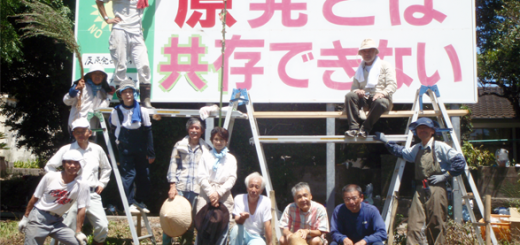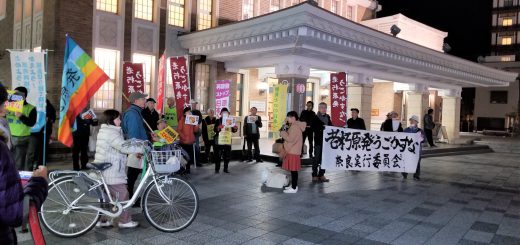Anti-Nuke Who’s Who: Kenji Higuchi – the most intriguing photographer you’ll ever meet Nuke Info Tokyo No. 84
Kenji Higuchi: The Most Intriguing Photographer You’ll Ever Meet
 Kenji Higuchi is a great friend of CNIC. He has contributed hundreds of wonderful pictures to our publications. Indeed, his pictures have received high ratings from around the world, and this year he received the Nuclear-free Future Award.*
Kenji Higuchi is a great friend of CNIC. He has contributed hundreds of wonderful pictures to our publications. Indeed, his pictures have received high ratings from around the world, and this year he received the Nuclear-free Future Award.*
Higuchi was born in 1937, a son of a farmer in Nagano Prefecture. Without any definite plans, he left Nagano for Tokyo in the late ’50s when he realized that Japanese agriculture, which was about to undergo a transition from manual labor to mechanized labor, had no future. But then his life was changed forever when he stumbled on Robert Capa’s picture exhibition, which stirred up a great desire in Higuchi to document the suffering of those at the bottom in Japan. He had no prior knowledge of photography, so he went to a photography school for two years and then worked as an assistant teacher for two and a half years.
Then came the second turning point. A man had committed suicide in protest against the pollution being caused by petro-chemical plants in Yokkaichi City, Mie Prefecture. Higuchi was extremely alarmed, and rushed to the city. At first, things did not go smoothly, as people were very skeptical about journalists. But when the victims took the matter to court, they were advised by their defense council to enlist the aid of journalists. From then on, people, who in all likelihood were also convinced by Higuchi’s earnest intentions, began to let him interview them. His involvement with Yokkaichi reached its final stage in 1972 with the court ruling in favor of the victims, and the subsequent publication of his first photograph collection.
Higuchi’s third turning point came when, in early ’70s, he learned about the fierce struggle against the plan to build a nuclear plant at Kashiwazaki-Kariwa. He rushed to the area to document the local residents’ struggle, and got involved with their campaign himself. Then he learned of Mr. Iwasa ‘ the first man to take the issue of workers’ radiation exposure to court. Again with little prior knowledge, Higuchi studied nuclear energy and radiation in order to clearly understand and document what Mr. Iwasa was talking about. Higuchi recalls saying to Mr. Iwasa that workers’ exposure would not become a social issue while they were alive, but that by making a record of Mr. Iwasa’s own suffering as well as the court case, they would leave material for those of the future generation that will sympathize with and carry on their work.
Ten, twenty, and thirty years have passed since then. Mr. Iwasa did not see workers’ exposure become a social issue within his lifetime, but Higuchi succeeded in significantly raising awareness of the issue with his evocative and spirited pictures. There is now a committee that organizes exhibitions of his pictures across the country. He has also been invited to many places to give lectures.
Higuchi is all too aware that it takes a long time, some times too long, for social struggles to even receive attention ‘ let alone to reach some kind of resolution. Now that he has received the Award, he says he is compelled to continue his work, though it is somewhat tempting to think about retiring and working on themes from his younger days. The piercing eyes of the farmer’s son, a photographer with no tolerance of injustice, will continue to shed light on the dark side of the ‘prosperity’ based on mass-use of energy and mass-consumption ‘ a condition only made possible by the suffering of those at the bottom.
(By Gaia Hoerner, based on an interview with Higuchi on 25 Sep. 2001)


